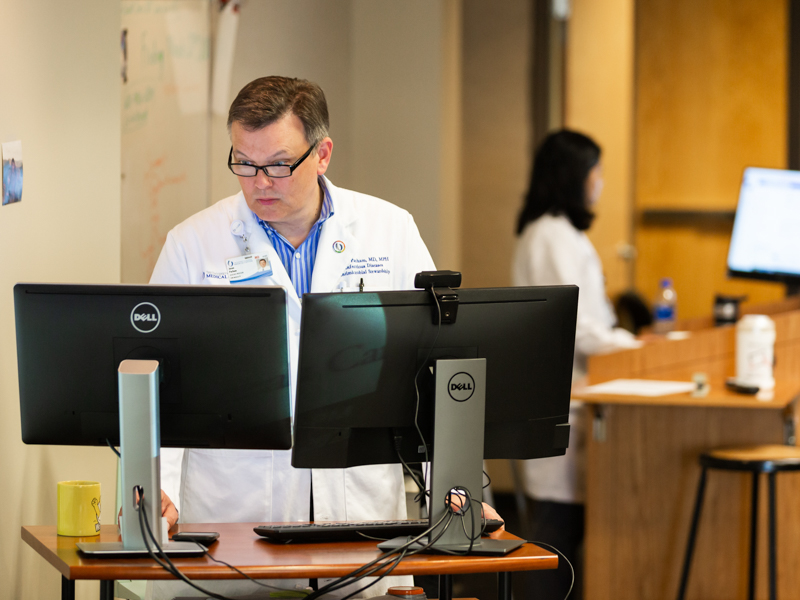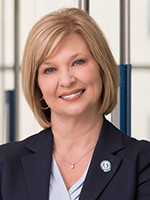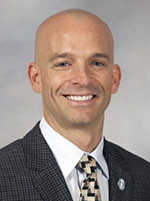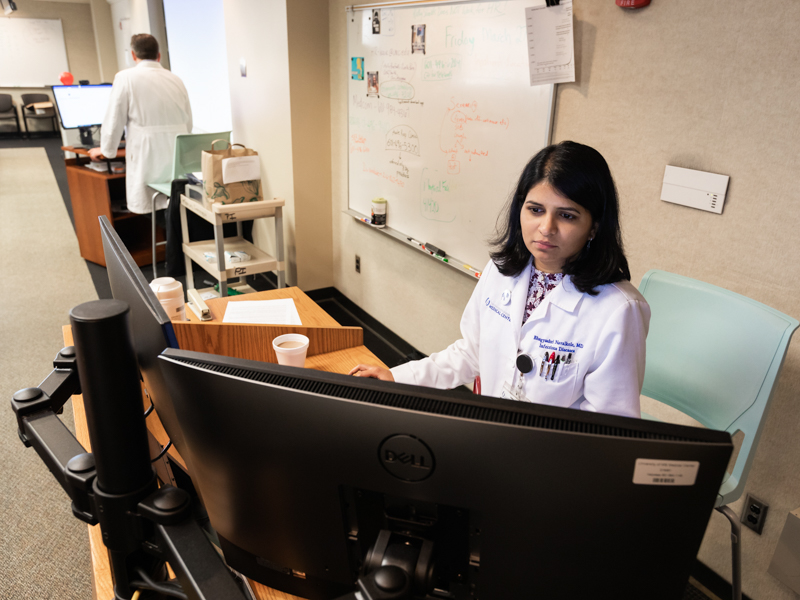Infectious diseases, prevention team keeps COVID-19 on the run

It was Christmas 2019 when Dr. Bhagyashri Navalkele began educating herself on the “pneumonia of unknown origin” that was cropping up in China’s Hubei Province.
So little was known about that novel, or new, coronavirus. Navalkele, medical director of infection prevention and control at the University of Mississippi Medical Center, was watchful, but not too worried.
“But in a few weeks, things literally doubled or tripled in the number of cases in China,” she remembered. “I thought, this is something that is going to spread like wildfire. It’s a new virus, and this whole population has zero immunity against it. If it’s going worldwide as a pandemic, it’s coming to the United States, and to Mississippi for sure.
“We needed to move quickly and start planning what to do.”

Dr. Jason Parham, director of UMMC’s Division of Infectious Diseases, had the same gut feeling. “I feel it still,” he said of sensing early on the viciousness of this particular coronavirus that scientists named COVID-19.
Parham and Navalkele are closing in on four months of preparations and response for a pandemic that no physician, no hospital and no health care community has fully wrapped their head around. But as COVID-19 approaches its plateau in Mississippi, the infectious diseases team they lead and the state’s only academic medical center are as ready as they can be.
“I think that despite the increasing number of actual COVID-19 cases over the last several weeks, our actual processes in infectious diseases and infection prevention have gotten a little less hectic,” said Parham, whose many duties include serving as executive vice chair of the UMMC Department of Medicine.
“We’ve been able to put guidance and procedures and policies in place so that things are easier to handle and the schedule is a little more routine.
“We are eating and sleeping more regularly.”
— — —
If you catch a glimpse of Parham striding across campus, headed to a COVID-19 incident command meeting, or on his way to check on a patient in the Medical Center’s ICUs or in University Hospital, chances are Navalkele is with him. Or vice versa.
Parham is an Amory native who grew up in Jackson and Clinton. He is a University of Mississippi School of Medicine graduate, completing his residency and fellowship in infectious diseases at UMMC and then earning a master’s degree in public health practices from the School of Public Health and Health Practices at the University of Massachusetts-Amherst.
He returned to the Medical Center in 2011 and today holds the academic rank of associate professor in both the School of Medicine and in the John D. Bower School of Population Health.
Navalkele is a native of India, receiving her bachelor of medicine and bachelor of surgery from Lokmanya Tilak Municipal Medical College in Mumbai and completing a residency in internal medicine at AtlantiCare Regional Medical Center in Atlantic City, New Jersey. She was a fellow in infectious diseases and in infection prevention and hospital epidemiology at Wayne State University and Detroit Medical Center.
She joined the Medical Center faculty in 2017 as an assistant professor in the Division of Infectious Diseases.
They are among the many front-line heroes of the Medical Center, working in partnership with those designated to care for the COVID-19 patients, feed them, monitor their ventilators, sanitize their rooms and hold their hands because their loved ones aren’t allowed to.

“The Medical Center is lucky to have Dr. Parham and Dr. Navalkele leading our infection intervention efforts,” said Dr. LouAnn Woodward, vice chancellor for health affairs and dean of the School of Medicine. “Since day one of our preparation and response efforts, they’ve brought a calming effect across our organization.
“In the face of a public health crisis, you hope to have the right people in the right positions at the right time, and we can say that happened here.”
Long hours are the norm for the foreseeable future for Parham and Navalkele, plus members of the Medical Center’s leadership team who spend countless hours in an incident command center for COVID-19 response. Woodward, who is also an emergency medicine physician, is the incident commander.

Dr. Alan Jones, chair of the Department of Emergency Medicine, serves as the clinical response leader for UMMC’s COVID-19 response. Dr. Jonathan Wilson, chief administrative officer, is incident manager and a veteran leader of emergency response for disasters including tornadoes and hurricanes.
They are the top decision-makers on the strong COVID-19 response expected of academic medical centers. At UMMC, that includes innovations that are far from the norm during this pandemic: clinical research and trials on how to treat the disease, researchers’ creation of an in-house COVID-19 laboratory test and a pediatric anesthesiologist’s invention of an emergency-use ventilator.
But it began with the basics, Navalkele said, including educating the Medical Center’s 10,000 employees in February on the virus, its symptoms and what was known at the time about its transmission.
“Spring break week, when I had my first discussions with a physician who made a diagnosis in Hattiesburg, it became very clear that the virus was here and that we were going to have local transmission,” Parham said. “It got much more real. We were answering questions from the Health Department and hospitals all over the place.
“That’s our job. We help when we can. But, we very quickly realized that we’d have to focus very intensely on what was happening at UMMC.”
In late February, the Medical Center created a hotline for employees to call with questions, concerns or suspicions that they were infected. For weeks, Navalkele and Parham, along with an expanding group of staff and volunteers, answered the phones. “It rang 24/7,” Navalkele said.

March was consumed with making sure front-line clinical staff were prepared for a rush of patients and adept at using personal protective equipment, or PPE, such as face masks, face shields, gowns and gloves. “We had to figure out what worked inside our system, what we had to adjust, and what we had to scale up over time,” Parham said.
He and other leaders shared information with other academic medical centers across the country. “That was key to us knowing what we were doing was correct,” Parham said.
Along with hospital leadership, Parham and Navalkele helped formulate policies that required students and employees who traveled over spring break to quarantine for two weeks. They led the charge on creating procedures for screening patients for the virus and keeping tabs on how many negative pressure rooms, designed to keep contaminated air from escaping, were available for COVID-19 patients.
“It was amazing to watch them run into the eye of this storm while it was growing, always level headed, accommodating, thoughtful and pleasant,” Jones said. “No matter the question or the time, they welcomed the opportunity to help anyone that asked for it. Truly inspiring to witness.”
— — —
The pace was grueling. “There were stretches in middle to late March where everything seemed like one long day,” Parham said. “It was very hectic trying to get everything ready.”
Every day, they are seeing the results, although this virus is far from finished with Mississippi. Creation of the in-house test, Navalkele said, was “a game changer” that allowed staff to confirm a COVID-19 diagnosis in hours instead of days, and to isolate only the patients who needed it.
The Medical Center’s careful stewardship of PPE has allowed front-line staff to have what they need. That hasn’t been the case in many New York City hospitals or other hot spots for the virus. Several of UMMC’s health care team have been treated for COVID-19, but none have died, unlike dozens nationally whose hospitals ran short on PPE.
Parham and Navalkele have given up a lot during the many weeks spent shaping policies to manage a pandemic. “Sunshine,” said Parham, a married father of two. “Seeing my parents. Meals with my family.”
They are meticulous about protecting loved ones by being meticulous about protecting themselves.

“You make sure you are taking your shoes off, washing your clothes, taking a shower before having any close contact with family,” said Navalkele, whose husband is a UMMC physician.
As the surge in patients brought by the disease’s peak approaches, Parham and Navalkele know their best-laid plans will be fully tested.
“Every day, we have at least 200 new cases and double-digit deaths in Mississippi. That has been steady,” Navalkele said. “We are prepared as we can be to make sure our staff has enough PPE, and we have enough staff to take care of our patients.”
She and Parham share deep concerns that Mississippians will let down their guard as the state’s shelter in place order expires.
“It’s likely that we will hit our first peak in patient numbers over the first part of May, and stay at or near that peak for a couple of weeks,” Parham said. “Hopefully then we will start to see the virus retreat a little, but it will be slow.
“I do worry about a return to the Mississippi of late February or early March, without adequate social distancing and hand washing, with people coming to work with symptoms of respiratory tract illnesses.
“I worry that if we go back to that stage, we will be in trouble very quickly.”


